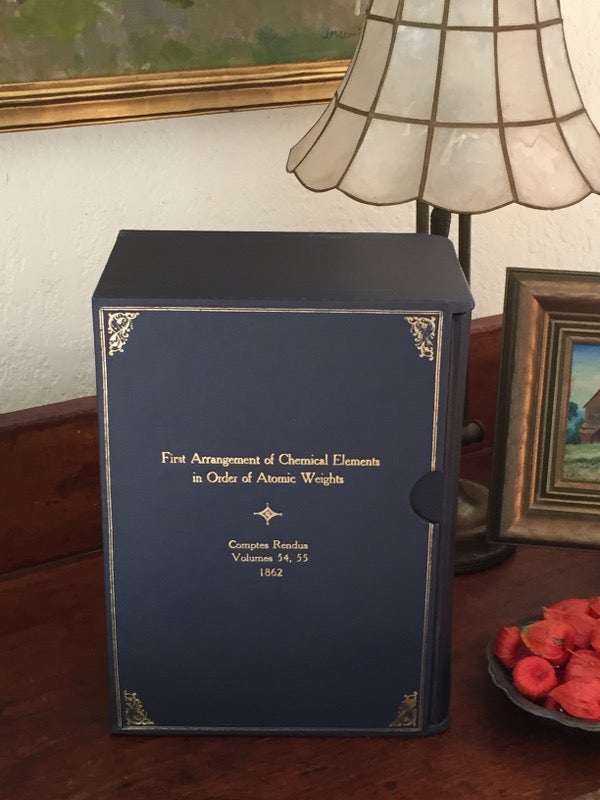Mémoire sur un classement naturel des corps simples ou radicaux appelé vis tellurique WITH Mémoire sur un classement naturel. addition au Mémoire WITH Sur un classement naturel des corps simples. addition au Mémoire WITH Tableau du classement naturel des corps simples, dit vis tellurique (in Comptes rendus hebdomadaires des séances de l’Académie des sciences), Vol. 54, No 13, No 15 a. No 17. pp. 757–761, 840–843, 967–971. AND Vol. 55, No 15. pp. 600-601.
Paris: Mallet-Bachelier. 1st Edition. TWO VOLUME 1st EDITIONS of de Chancourtois’s seminal papers in which he is “the first scientist to arrange the chemical elements in order of their atomic weights” (Helmenstine, “Who Invented the Periodic Table”). Years before Newlands announced his Law of Octaves and Mendeleev described his Periodic System, de Chancourtois transcribed a list of the elements positioned on a cylinder in terms of increasing atomic weight. When the cylinder was constructed so that 16 mass units could be written on the cylinder per turn, closely related elements were lined up vertically. This led de Chancourtois to propose that "the properties of the elements are the properties of numbers" (Chancourtois).
“There are valid reasons for declaring that the periodic system was essentially discovered in 1862 by de Chancourtois, a French geologist. de Chancourtois appears to have taken not just an important step in the story of the periodic system but, in many ways, the single most important step. It was he who first recognized that the properties of the elements are a periodic function of their atomic weights, a full seven years before Mendeleev arrived at the same conclusion” (Scerri, The Periodic Table, 68 ).
“Although he hit upon this crucial notion underlying the entire edifice of the periodic system, de Chancourtois is not generally accorded very much credit because his publication did not appear in a chemistry journal, and because he did not develop his insight any further over subsequent years… It was only about 30 years after his paper appeared that de Chancourtois’s claim to priority came to light through the efforts of [later scientists]… Still, it cannot be denied that De Chancourtois was the first to show that the properties of the elements are a periodic function of their atomic weights" (ibid).
In this paper, “de Chancourtois arranged the elements according to what he termed increasing “numbers” along a spiral. These numbers were written along a vertical line that served to generate a vertical cylinder. The circular base of the cylinder was divided into 16 equal parts. The helix was traced at an angle of 45 degrees to its vertical axis, and its screw thread was similarly divided, at each of its turns, into 16 portions. Thus, the seventeenth point along the thread was directly about the first, the eighteenth above the second, and so on. As a result of this representation, elements whose characteristic numbers differed by 16 units were aligned in vertical columns” (ibid., 69).
ALSO: Foulcault’s first terrestrial measurement of the speed of light in absolute units (i.e. kilometres per second) (pp. 501-503, pp. 792-796) and his technique was later developed by Michelson and Morley in their famous experiment in 18878. ALSO Pierre Janssen’s description of his pocket spectroscope as well as that of Jean Georges Hofmann (books have been written about their feud: Hofmann believed himself to be the inventor of the spectroscope, but it was Janssen who first described it in this paper (pp. 576-578). Item #516
CONDITION: Two volumes. 4to. Large and heavy 4to (11 x 9.5 inches). Ex-libris, slight ‘ghosting’ from removed labels at the spine; only two interior stamps, one on title page, one on rear of tp. Very solidly bound in blue buckram, gilt-lettered spine. Slight smudge on two of the papers. Light toning the preliminaries and very occasionally within, otherwise very bright and clean throughout. Handsome wide margins. Very good condition.
Price: $1,250.00

